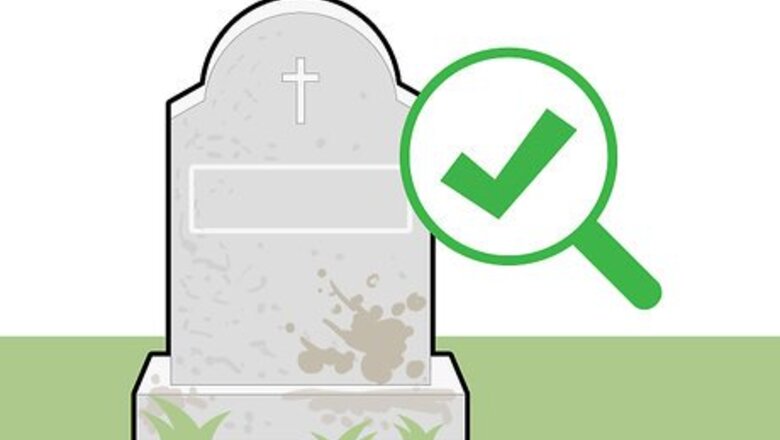
views
- Check the gravestone for cracking, flaking, or chipping before you begin cleaning. If the grave has any of these problems, it's not safe to clean.
- Use a gentle brush and water to scrub the surface of the gravestone. Never use harsh cleansers like bleach or liquid dish soap.
- Spray the gravestone a headstone cleaner like D/2 to remove lichen and moss. Let it dry on the surface or scrub the stone for immediate results.
Best Cleaning Techniques

Clean gravestones to remove biological growth or stains. Consider whether the gravestone really needs it—after all, every gravestone develops a patina, which is a slight darkening that comes with age. Clean a gravestone if there's biological growth like algae, lichen, or fungi because these trap moisture and they're acidic, which can damage the stone. If you see ivy, ferns, or moss growing over the headstone, it is a good idea to clean it. These plants also trap moisture and the roots can break up the stone. Wait to clean the gravestone until the weather is mild. If you decide to clean the headstone when it's very cold or excessively hot, the stone could crack when you clean it.
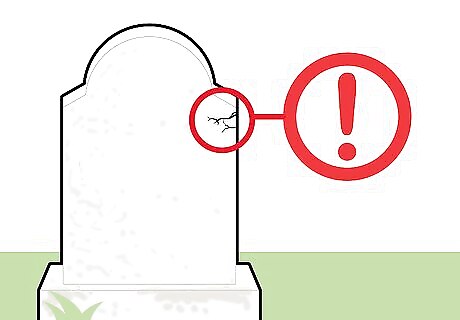
Check the gravestone for cracks, flaking, or chipping. Gently tap the surface of the gravestone and do not clean it if you hear a hollow sound—this is a sign that the interior of the stone isn't strong enough. Look at every side of the monument for damage like cracking, flaking, or excessive wearing since this means the stone is weak. Do not clean a gravestone that's already broken or looks unstable. Gravestones can fall over and injure people, so be cautious when you're cleaning in a cemetery. If you're not a relative of the deceased, ask the family for permission or ask the cemetery for permission if you can't locate a family member.
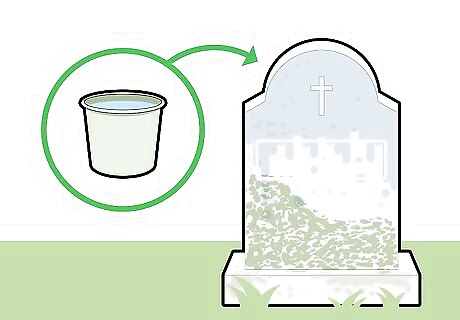
Pour water over the stone to soak it thoroughly. You probably won't have an easy way to access water in most cemeteries, so plan on bringing at least 5 gallons (19 L) of water for each gravestone you plan on cleaning. Store the water in large jugs or put it in a low-pressure pump sprayer. Never use an electric pressure washer on a gravestone since it will blast off the surface of the stone.
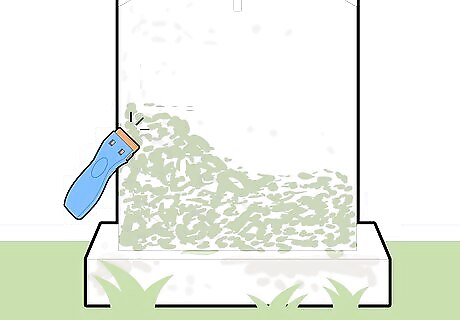
Scrape off lichen, moss, and fungi with a plastic scraper. Press the scraper onto the surface gravestone and gently scrape from the top to the bottom. You don't have to press very hard to get the biological growth to fall away. To get lichen or moss out from carved letters or images on the stone, take a wooden popsicle stick or a bamboo skewer and scrape the material out. If you don't have a plastic scraper, use a wooden scraper. While it might be tempting to reach for a metal tool, metal is too abrasive and it could scratch the surface of the headstone. If there are vines or plants growing over the headstone, don't pull them out or you could damage the gravestone. Instead, cut the plants down to the ground and wait a few weeks until they die. Then, gently pull the dried plant out of the soil.
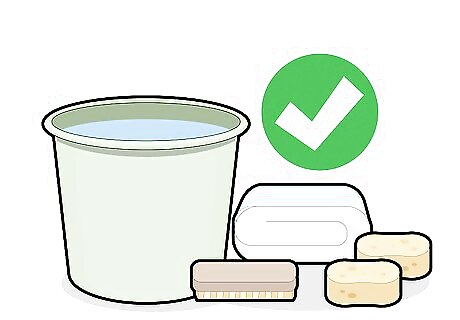
Scrub the surface of the gravestone with a soft bristle brush. Dip the brush in water and gently scrub near the bottom of the gravestone to loosen the grime. If you're cleaning marble or limestone, use a sponge that's even gentler than a soft bristle brush. Work in a circular motion and don't press hard—even gentle contact with the stone will contribute to wear, especially for marble and limestone. Keep scrubbing up until you reach the top of the gravestone. Repeat this for each side. It might seem counterintuitive to clean from bottom to top, but working this way prevents limescale from forming. To remove graffiti, work fast and clean the stone as soon as possible. Dip a soft bristle brush in water and scrub the gravestone. If the graffiti doesn't come off, spray D/2, a non-ionic cleanser, on the stone and scrub with a brush. Gain knowledge to start a gravestone care business. "As I consider launching a small business cleaning and restoring gravestones, this guide impressed me with its grasp of specialized techniques. The insights on assessing stone stability, choosing non-abrasive tools, using biodegradable cleaners, and when to intervene will help me provide quality care. Now, I feel equipped with the knowledge needed to start an ethical restoration service." - Walter O. Save stone from well-intentioned damage. "I'll admit my first instinct was to reach for household bleach to clean my grandfather's weathered gravestone. Thank goodness this article stopped me in time! Who knew bleach could degrade the stone and do more harm than good? The tips on gentle circular scrubbing and biodegrading spray cleaners set me straight on protecting, not damaging, this precious memorial." - Diane L. Express amused skepticism of odd advice. "I had to chuckle when I read the suggestion to place snails on gravestones and let them eat away growths. While an inventive thought, it seems impractical compared to using this guide's reliable scrub brushes, wooden picks, and biodegrading washes to gently clear moss and lichens. I appreciate the author's more realistic cleaning recommendations." - Ken N. Gain knowledge to preserve vandalized monuments. "Seeing the graffiti and damage done to my ancestors' gravestones broke my heart. As descendants, my family feels responsible for caring for these memorials. The techniques here on assessing cracks, scrubbing with soft brushes, using a biodegrading spray, and when to call experts gave me the knowledge to clean and preserve what remains properly." - Ray L Did you know that wikiHow has collected over 365,000 reader stories since it started in 2005? We’d love to hear from you! Share your story here.
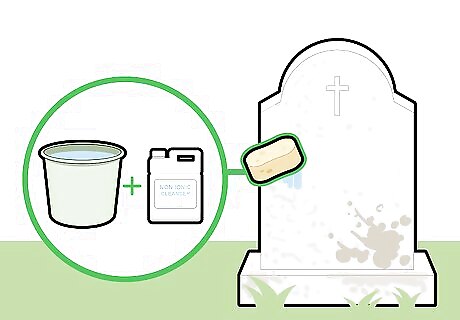
Apply a non-ionic cleanser like D/2 to remove tough stains. If you're unhappy with how much grime is still on the gravestone, spray undiluted D/2 over the entire surface of the stone—this cleanser doesn't contain harsh salts that can damage gravestones. To get immediate results, let the product sit for 5 to 10 minutes before spraying it again. Then, scrub the stone with a gentle brush before you rinse it with plain water. Because non-ionic cleansers continue to work after you've applied them, you can spray the stone and simply let it air dry. When you come back weeks or months later, you'll be surprised at the improvement!
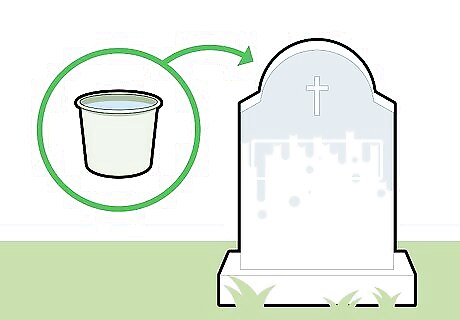
Rinse the gravestone with plain water. Once you've scrubbed the surface or finished using a non-ionic cleanser, pour water over the entire stone to rinse away grime and debris. Remember, you're trying to remove grime and organisms that could damage the gravestone—don't worry if it doesn't look pristine. You've looked after the gravestone and prevented further damage.

Work with the most gentle tools and cleaning agents. It's hard to overstate how important it is to do no harm. It's really easy to accidentally be too rough on old, weathered stone. Here are a few things you should never use to clean a gravestone: Bleach or chlorine Vinegar or acidic cleansers Metal tools, wire scrub brushes, or abrasive pads Household cleansers like dish soap or detergents Pressure washers or sandblasters
Care and Maintenance

Clean a gravestone every 4 to 6 years to prevent excess wear. It might surprise you to hear that gravestones shouldn't be cleaned often. In fact, some experts recommend waiting 4 to 6 years in between cleanings! This prevents frequent wear from weakening the stone. Write down the date you clean the gravestone so you can refer back to when you last cleaned it. If the cemetery provides regular maintenance, ask them about how often they clean the gravestone.
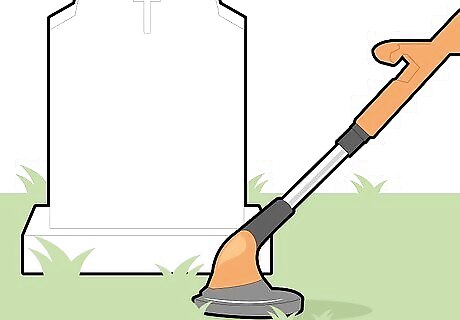
Clear the growth around the gravestone. Use loppers or a weed eater to cut back trees and vines that are growing over the gravestone, as well as any plants that make it hard for cemetery workers to mow around the stone. Although lilacs, roses, or hardwood trees make lovely additions to a cemetery, if they're too close to to the headstone, their roots can damage the stone. Ask the cemetery for permission before you remove plants. They might have a groundskeeper that can clear the area of growth for you.

Leave flowers or memorial tokens if you'd like to honor a loved one. Ask the cemetery about their regulations before you decorate a grave site. If allowed, you might leave flowers, a candle, or a token that represents something your loved one enjoyed. Many people leave special tokens of remembrance on holidays, anniversaries, or birthdays.


















Comments
0 comment